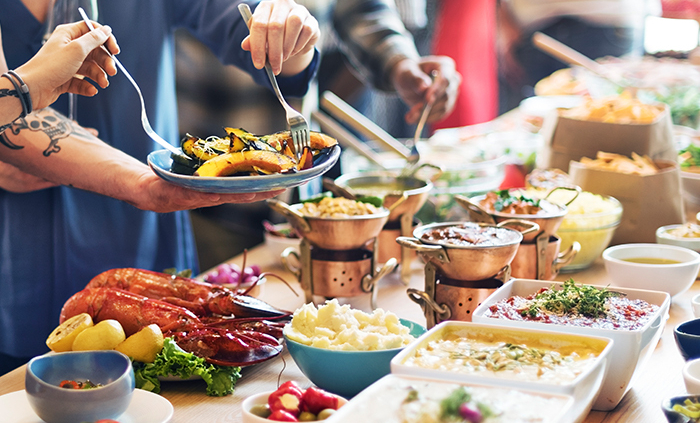If you’re planning an event near the holidays, have you considered how you’ll handle the culinary aspect of the event (that is, if you are planning to offer food and drink)? If you’re not planning to treat attendees to gastronomic delights, there’s something you should know. According to a survey of 2,000 Americans, food is the second most important factor people consider when deciding to attend any type of event — more important than both the quality of the speakers/performers and who else is attending. 62% of the respondents would go to an event just for the food, and 77% say food is important when attending any public event. So, as an event manager, you’d be wise not to make food an afterthought.
Budget Considerations
The way you handle the food aspect of your event will be part of your branding, so when making your menu selections be creative and bold. Don’t be afraid to take risks. You don’t want to simply fill attendees’ bellies or choose the most affordable option.
Of course, the budget should be considered (you can’t serve lobster on a bologna budget), but to make the most of your food budget, aim to make food a part of the overall immersive event experience.
Here are some affordable ways to offer a fun and memorable food experience:
- Interactivity: If you’ve visited a bd’s Mongolian Grill restaurant, you know how much fun it is to participate in the preparation of your meal. Offer “create-your-own” stations for salads, sundaes, etc. Include healthy and vegan options for attendees with dietary restrictions.
- Buffet style/Food stations: Plated dinners are often more expensive (servers have to be paid) than budget-friendly options like serving buffet-style or offering specialty food stations. Create interest by having each station centered around a theme or cuisine.
- Dessert-only: Don’t feel that you have to offer a full meal. Depending on the time of your event, a spread of desserts and beverages (coffee, tea, sparkling water) will work nicely. A chocolate fountain with yummy things to dip (fruit, cookies, marshmallows) is always a crowd favorite. Or, how about a spread of traditional holiday desserts (Yule log cake, pfeffernusse, gingerbread cookies)
Keep it Safe
With conference-style events, attendees usually don’t eat while the event is in progress. They eat before, after, or during a break in the program. Since everyone is eating at once, crowds will likely form around the food-serving areas. To avoid over congested areas, you want to ensure that your layout allows for splitting the crowd up. Having multiple food stations is a great way to do this. During the planning process, incorporate spatial planning tools such as eShow’s Exhibit Sales & Floor Plan Management module to simplify all of your floor plan tasks.
Add an extra layer of protection by having all servers wear masks and using signs that direct attendees to wait until the current person is served before approaching serving tables.
Selecting a Caterer
If you’ve settled on an event near the holidays, keep in mind that this is a busy time for caterers, so you’ll need to book as far in advance as possible. Using your venue’s on-site food service is another option but often more expensive than bringing in your own caterer.
When working with a caterer, the following will help you cover all of your bases to ensure that everything goes smoothly:
Contract: Make sure you have a detailed, signed contract that includes your menu, costs, a list of expected tasks (i.e., who will be responsible for cleaning up the food serving areas?), the layout of the event space, and the day’s schedule (so the caterer knows when you expect food to be served).
Dietary Restrictions: Although you won’t know about all of your attendees’ dietary restrictions ahead of the event, ask the caterer to include vegetarian/vegan options within the menu. (On event day, have these options clearly marked).
Vendor Contact List: If you’ll use multiple vendors to supply your treats, it’s a good idea to create a list of all vendors along with the names and phone numbers of all points of contact.
Walk-Through: If food stations are part of your event’s food experience, if feasible, have the caterer visit the venue to get a sense of how everything should be efficiently and safely set up.
Don’t Forget Virtual Attendees
If you’re planning a virtual or hybrid event, all attendees can still be part of the culinary experience, even if they don’t attend in person. If your event’s food offerings are centered around a theme, send food gift baskets with that same theme to the virtual attendees. Or, partner with a food retailer to obtain gift cards/coupons (hopefully at a discount or gratis) in exchange for promotion in your event advertisement.
Final Thoughts
Now that you know that event attendees place food high on the importance scale, you need to ensure that their dining experience is just as enjoyable as other parts of the event. You don’t need a massive budget to accomplish this. Creativity and resourcefulness will go a long way in satisfying attendees’ taste buds in a way that they’ll remember.
For health and safety precautions, insist that all food servers wear masks. Ensure the comfort of all by devising a plan to safely distance attendees in the dining space. Let eShow’s interactive Exhibit Sales & Floor Plan Management module help you make the most of your venue layout. You’ll see ahead of time how best to set up food stations for efficient and safe serving.
At eShow, we have everything you need for a successful and memorable event all under one “roof.” From planning to execution, we’re with you every step of the way. Contact us today for a no-obligation demo, and let us show you why we’re the “go-to” supplier for event management.







